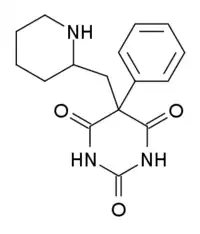Prazitone
Prazitone (AGN-511) is a barbiturate derivative developed in the 1970s.[1] Unlike most barbiturates, it has little or no sedative effects, instead acting as a non-sedating anxiolytic and antidepressant.[2] The dosage range in humans is around 200–600 mg, although higher doses have been used in trials for the treatment of depression associated with Parkinson's disease.
 | |
| Clinical data | |
|---|---|
| Other names | 5-phenyl-5-(2-piperidylmethyl)barbituric acid |
| ATC code |
|
| Identifiers | |
| |
| CAS Number | |
| PubChem CID | |
| ChemSpider |
|
| UNII | |
| Chemical and physical data | |
| Formula | C16H19N3O3 |
| Molar mass | 301.346 g·mol−1 |
| 3D model (JSmol) | |
| |
| |
| | |
References
| |||||||||||||||||||||
| |||||||||||||||||||||
| |||||||||||||||||||||
| |||||||||||||||||||||
| |||||||||||||||||||||
This article is issued from Wikipedia. The text is licensed under Creative Commons - Attribution - Sharealike. Additional terms may apply for the media files.